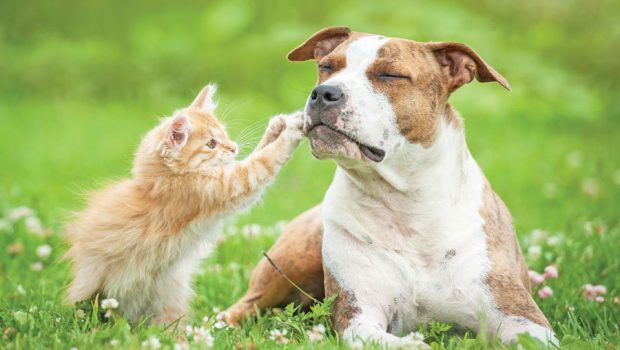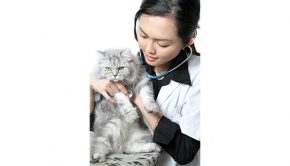NONTOXIC LAWN CARE
Protecting Pets and the Planet
by Marlaina Donato
Warmer weather has arrived, and so begins many homeowners’ annual quest for a well-nourished, weed-free lawn. However, the grass isn’t always greener—or healthier— using conventional approaches.
Turf grass covers up to 50 million acres of American land, and according to the U.S. Environmental Protection Agency, about 60 million pounds of synthetic pesticides are used each year in yards and gardens, in addition to tens of millions more pounds applied in parks, schoolyards and other public spaces.
Americans spend billions of dollars growing and maintaining manicured lawns resulting in a high price for pets, people and wildlife. Nitrogen from fertilizers seeps into surface water and groundwater, contaminating wells and spawning harmful algae blooms; pesticides kill off more than 70 million birds each year in the U.S. alone; and bees and other pollinators are also succumbing to the toxic chemicals at an alarming rate.
Pets at Risk
Chemicals routinely used in lawn care are especially problematic for the family dog or cat. “Animals are close to the ground, and their feet touch the ground, so every substance you choose to allow in your home and yard will affect them,” says Ashley Geoghegan, DVM, of VetNaturally, in Mandeville, Louisiana.
A study conducted by the Department of Veterinary Clinical Sciences at Purdue University concludes that common lawn chemicals like glyphosate, 2, 4-D and permethrin are linked to canine bladder cancer. A six-year study by the Foster Hospital for Small Animals at the Tufts University Cummings School of Veterinary Medicine reveals that exposure to professionally applied lawn pesticides and herbicides increased the risk for canine malignant lymphoma by 70 percent.
In pets, chronic or sub-chronic exposure to conventional lawncare chemicals manifests as eye damage and thyroid, urinary and reproductive conditions. Feline gastrointestinal distress is also a consequence, and even indoor cats are at risk from contaminants brought into the home.
“Anything that goes on your lawn goes into your pet’s body. Pets walk through it, roll in it and then groom themselves,” says Michele Yasson, DVM, of Holistic Veterinary Services, in St. Augustine, Florida. “Max, one of my canine patients, developed acute, life-threatening pancreatitis just hours after his yard had been treated by a commercial lawncare service.”
Go Natural for Lush Lawns
Opting for a toxin-free lawn helps grass roots to anchor deeply into the earth, making them less likely to fall victim to weeds, disease and drought. An organic lawn has beneficial microbes; helpful insects like ladybugs and lacewings thrive, while pesty insects decline.
Instead of chemical fertilizers and “natural” alternatives like borax, vinegar, garlic, essential oils and cocoa mulch, which can also be toxic to pets, try using grass clippings, seaweed, corn gluten meal, single-ingredient bone meal, diatomaceous earth or Bacillus thuringiensis (BT); all are better options.
Redefining beauty and working with nature can also have a positive impact. “Set a goal to gradually reduce the area of your yard devoted to grass, and begin to establish plants like butterfly bush or bee balm that support pollinators such as bees,” recommends Sandy Long, of Greeley, Pennsylvania, a knowledgeable pet parent and executive director of the nonprofit environmental education organization SEEDS (Sustainable Energy Education and Development Support).
Simple Precautions
Simple precautions like removing shoes before entering the house, storing lawn products out of reach of pets and avoiding conventionally treated areas for at least 48 hours after application are paramount. Also:
- Close windows during application.
- Increase frequency of pet baths during spring and fall, when chemical application is highest.
- Eliminate accumulation of water on lawns where pets might drink.
- Leash pets during walks to keep them away from treated areas.
- Wipe paws with a damp cloth after being outside.
After weighing alternatives, dog trainer Rebecca Porter, owner of Rosy Dogs, in Stoughton, Wisconsin, settled on prescribed burns, mowing and hand removal of invasive plants. “It works, and now my dog gallops safely through the waist-high grasslands. As for my yard, I enjoy the volunteer plants. It’s a decision all landowners can make.”
Marlaina Donato is the author of several books and a composer. Connect at AutumnEmbersMusic.com.
<












